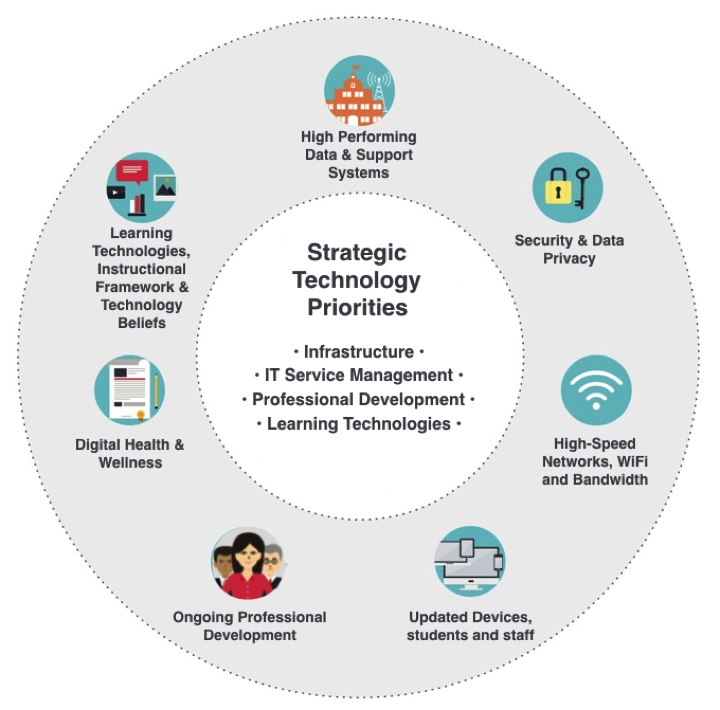技术规划和战略优先事项

如今,技术规划的性质与以往一样重要,正在从 "技术清单 "向 "服务能力 "模式转变。技术已从 "很好拥有 "转变为 "很重要",现在已被视为一项关键的战略资产。包括教育在内的几乎所有垂直行业都采取了这种观点。一些最先进的技术规划故意不提出具体的技术,而是规划核心基础设施和支持流程的能力,使组织能够灵活地以最佳方式实现其战略目标,并满足快速迭代的需求,而快速迭代是创新的关键组成部分。
战略技术优先事项由 Minnetonka 技术教师团队制定,并参考了媒体专家、技术部员工、教学部员工、2016 年国家教育技术计划、技术行业专业人士、类似高绩效学区的首席技术官和技术主管的意见。
四项基本的技术优先事项以原则为基础,旨在为服务于学区使命的技术实施的基本工作提供框架。在未来几年里,新的技术、计划、实践和教学手段将不断出现,这里的优先事项旨在对这些技术和实践进行评估、设计、实施、支持和培训。
四个战略重点
以下优先事项旨在支持学区的总体任务,同时支持业务和教学领域。业务运营和新兴的 "教与学教学框架 "都是以下广泛的战略技术优先事项所支持的重要领域。每个领域对支持学区的工作都至关重要。
-
- 优先事项 1:基础设施
- 优先事项 2:信息技术服务管理(ITSM)
- 优先事项 3:专业发展
- 优先事项 4:学习技术
优先事项 1:基础设施
- 带宽、局域网和广域网:随着媒体内容的丰富、设备的激增以及数字学习资源质量的不断提高,带宽需求也在不断增长,内部和外部网络必须跟上预计的需求。这包括内部交换和吞吐量、WiFi、外部带宽和相关网络冗余系统。
- 数据系统:需要大量的基本服务和数据库来支持业务和教学工作。运行这些应用程序的数据系统在配置上必须尽可能提供高可用性和持续可用性。这些系统包括财务、人力资源、学生系统通信系统(电话、电子邮件、网站)、Skyward Family Access、Schoology 和许多其他基础设施服务。
优先事项 2:信息技术服务管理(ITSM)
- IT 服务管理:信息技术基础设施库(ITIL)是一套信息技术服务管理(ITSM)实践,其重点是使信息技术服务与业务需求保持一致。ITIL 和 ITSM 是学区采用的最佳实践,旨在提供一个技术生态系统,以最好地满足学区的愿景、战略目 标、业务运营和 "教学指导框架 "的所有八个方面。
- 安全、身份和政策管理:身份管理、安全和威胁缓解已变得越来越重要,并将继续成为全学区所有用户群体 (学生、家长、教职员工和社区)的高度优先事项。应尽可能使用一致的自动身份管理工具,最大限度地减少潜在的用户账户管理错误,实现用户账户的快速入职和准确离职。安全工具和警报系统以及安全最佳实践的不断发展在安全管理中发挥着关键作用。
- 学生、家长、教职员工和社区访问:获得可靠的技术(硬件、软件、基础设施、支持和培训)对学区的使命至关重要。为学区社区提供适当的、可持续的设备更换周期、软件更新以及有效的支持和培训是一项重要的优先事项。为工作人员和社区提供的服务台人员配备完善了大量的数字支持辅助工具。基础设施设备和学生设备的定期更换周期需要在多年周期内进行规划和预算。
优先事项 3:专业发展
- 这一重要领域每年的投入约占整个技术预算的 15%,但在行业中却常常被忽视。专业发展可以利用其他技术投资,确保真正的实施。计划周密、持之以恒的专业发展是成功采用和深度整合技术的关键要素。培训应具有针对性、经常性和差异性。
优先事项 4:学习技术
- 有时也称为 "教育技术",这是一个非常大的领域,涉及将技术融入教学实践、选择最合适的学生和教职员工设备、选择学习软件应用程序、数字教学实践、研究与开发、数字公民、健康与平衡、专业发展以及旨在加速和深化学习的政策和计划。这是受益于高性能基础设施最多的领域,因为学习技术领域往往是最先测试和实 施新技术和潜在改进技术的领域,通常也是数量最多的领域。
- 明尼通卡技术信念声明:2014 年春季,iPad 实施领导小组就一系列信念声明达成一致,这些声明将继续用于指导我们的决策和技术实施。明尼通卡的教学模式建立在夏洛特-丹尼尔森框架之上,除其他关键教学策略外,还包括强调将个人技术融入课堂。
